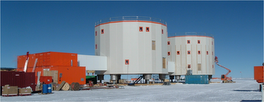Earth's core less anisotropic than we thought?
One of the reasons for installing seismic stations in Antarctica is to improve our knowledge of the Earth's inner core. It would seem - from the data currently available - that seismic waves that propagate through the inner core parallel to the Earth's rotation axis (polar paths) are faster than those that propagate perpendicular to the Earth's rotation axis (equatorial paths). This speed difference implies the inner core is anisotropic, with a N-S fast axis.
This conclusion is based on a large number of equatorial paths, and only a small number of polar paths, most of which come from earthquakes in one particular region (South Sandwich islands) recorded in Alaska. Data from new stations in Antarctica are expected to increase the number of polar paths available, and improve our understanding of the inner core.
At EGU this morning, I heard one of the first talks on the inner core that actually uses data from newly deployed Antarctic stations:
D. Leykam, H. Tkalčić, and A.M. Reading : Core structure reexamined using new teleseismic data recorded in Antarctica: Evidence for, at most, weak cylindrical seismic anisotropy in the inner core (Abstract).
The data are from the SSCUA stations, deployed near Mawson station. The PKP(bc-df) measurements made on these data are all between 0 and 2 seconds, and imply that if there is N-S oriented anisotropy in the inner core, this anisotropy must be weak (and specifically, much weaker than implied by the South Sandwich data). Indeed, the weak anisotropy hypothesis seems to be consistent with all data except those from South Sandwich.
Should we therefore dismiss anisotropy in the inner core? Possibly. But before doing so we need more data and measurements from other Antarctic stations (the CASE-IPY and Concordia stations will contribute some of these data), and we need to understand why the PKP(bc-df) measurements from South Sandwich events are so large.




No comments:
Post a Comment